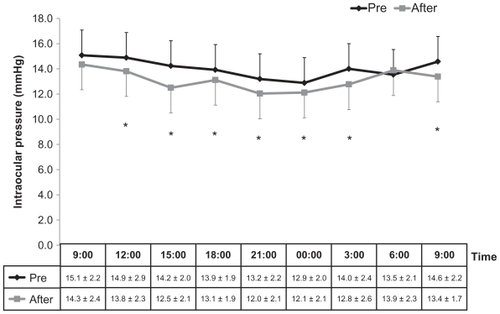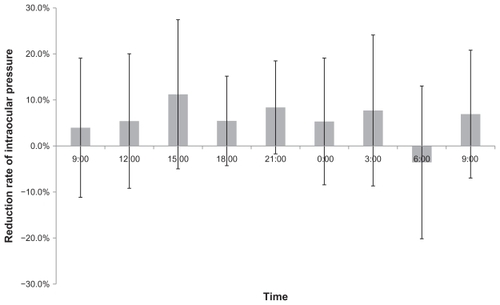Abstract
Purpose
To prospectively evaluate the diurnal variation of intraocular pressure (IOP) during unoprostone treatment in 13 healthy volunteers.
Method
IOP was measured by Goldmann applanation tonometry by the same observer every 3 hours from 9 am to 9 am the next morning. Unoprostone was then instilled at 9 am and 9 pm daily for 1 month. After 1 month, IOP was measured again with unoprostone instilled at 9 am and 9 pm during IOP measurement. We then compared the average daily IOP before and after the treatment (paired t-test).
Results
After 1 month of treatment, the average IOP decreased at every time point but one (12 pm, 3 pm, 6 pm, 9 pm, 12 am, 3 am, and 9 am, but not at 6 am). There were no adverse reactions and none of the subjects discontinued unoprostone.
Conclusion
The hypotensive effects of unoprostone persist throughout the day, but this study suggests that the effects may be weaker at nighttime and early in the morning.
Introduction
There are diurnal variations of intraocular pressure (IOP). So we must consider not only IOP values during the daytime but also nighttime when selecting glaucoma eyedrops. Unoprostone isopropyl (unoprostone) reduces IOP due to increased uveoscleral outflow.Citation1 There are few reports on the diurnal variations of IOP with unoprostone treatment.Citation2–Citation4 The purpose of this study was to prospectively evaluate diurnal variations in IOP after unoprostone treatment.
Methods
The study included 13 healthy volunteers (six men and seven women) with 26 eyes without ocular disease except for abnormal refraction. The mean age ± SD (range) of the subjects was 33.6 ± 8.5 years (22–48 years). Refraction was −1.8 ± 2.0 D (−4.75 to 0.75 D). The IOP was measured by Goldmann applanation tonometry by the same observer every 3 hours over a 24 hour period from 9 am to 9 am (next morning). Before measurements, the examinees sat down quietly for more than 5 minutes. Drinking alcohol, vigorous exercise, smoking, and drinking large amounts of water (more than 1 L) were prohibited. During the study period of 1 month, subjects worked from 9 am–6 pm, ate dinner and took some rest (watched TV, or undertook other recreational activities) from 6 pm–9 am, and slept from 9 pm–9 am. Unoprostone was instilled daily at 9 am and 9 pm in both eyes for 1 month. One month after treatment, IOP was remeasured over a 24 hour period, with a drop of unoprostone being instilled at 9 am and 9 pm on the day of IOP measurement.
The average IOP was analyzed using a paired t-test to compare pre- and post-treatment values. A P value of 0.05 was used to declare significance. The reduction rate of IOP was calculated at every time point. Adverse reactions were evaluated before and after 1 month of treatment. The subjects signed an informed consent document before participation.
Results
The average IOP after 1 month of treatment (13.1 ± 1.6 mmHg) was significantly decreased compared with that before treatment (14.0 ± 1.7 mmHg, P < 0.05). The average IOP at each time point after 1 month of treatment was significantly decreased compared with that before treatment, except at 6 am, where the value increased slightly but not statistically significantly (). The reductions in IOP from baseline were: 4.0% ± 15.1% at 9 am, 5.4% ± 14.6% at 12 pm, 11.2% ± 16.2% at 3 pm, 5.4% ± 9.7% at 6 pm, 8.4% ± 10.1% at 9 pm, 5.3% ± 13.8% at 12 am, 7.7% ± 16.4% at 3 am, −3.6% ± 16.6% at 6 am, and 6.9% ± 13.9% at 9 am the next morning (). Adverse reactions were not observed, and no one discontinued use of unoprostone.
Discussion
Takase et al reported that after instilling unoprostone as a single dose into eleven healthy volunteer’s eyes, the IOP decreased significantly 2 and 5 hours after instillation, and the reduction value in IOP was 1.3–3.3 mmHg.Citation2 In this study, the change in IOP was from –1.7 to 0.3 mmHg when measured every 3 hours; it is unknown why our results were lower in value. Stewart et al reported that IOP decreased significantly after daily instillation of unoprostone over 2 weeks in 24 patients with primary open-angle glaucoma (POAG) or ocular hypertension, and the IOP changed from 23.4 +/− 2.0 mmHg at baseline to 19.3 +/− 4.4 mmHg.Citation3 In a study by Araie et al,Citation4 on POAG or ocular hypertension in ten eyes of five patients, unoprostone was instilled into the eyes daily for 4 weeks. The IOP was measured every 2 hours from 9 am to 9 pm before and after instillation and results were compared. Measurements were not taken during the night in Araie’s study. The IOP decreased significantly at 9 am, 11 am, 5 pm, 7 pm, and 9 pm and the reduction in IOP was 1.3 to 3.7 mmHg 4 weeks after treatment. In our study, the lesser reductions obtained may be because the IOP before treatment (14.0 ± 1.7 mmHg) was lower than that in Stewart’s study (23.4 ± 2.0 mmHg)Citation3 and Araie’s study (22.7 ± 0.5 mmHg).Citation4 The IOP decreases in our study were significant (P < 0.05) except at 9 am the first day and 6 am the next morning, suggesting that unoprostone acts to reduce IOP throughout the day. However there is a possibility that the hypotensive effect of unoprostone weakens at night and in the early morning.
Disclosure
The authors report no conflicts of interest in this work.
References
- SakuraiMAraieMOshikaTEffects of topical application of UF-021, a novel prostaglandin derivative, on aqueous humor dynamics in normal human eyesJpn J Ophthalmol19913521561651779485
- TakaseMMuraoMKoyanoSOkitaMUenoROcular effects of topical instillation of UF-021 ophthalmic solution in healthy volunteersActa Soc Ophthalmol Jpn1992961012611267
- StewartWCStewartJAKapikBMThe effects of unoprostone isopropyl 0.12% and timolol maleate 0.5% on diurnal intraocular pressureJ Glaucoma1998763883949871860
- AraieMSakuraiMSuzukiYEffect of UF-021 and timolol on diurnal fluctuation of intraocular pressure in patients with primary open-angle glaucoma or ocular hypertensionJ Eye (Atarashii Ganka)1993101221172121

